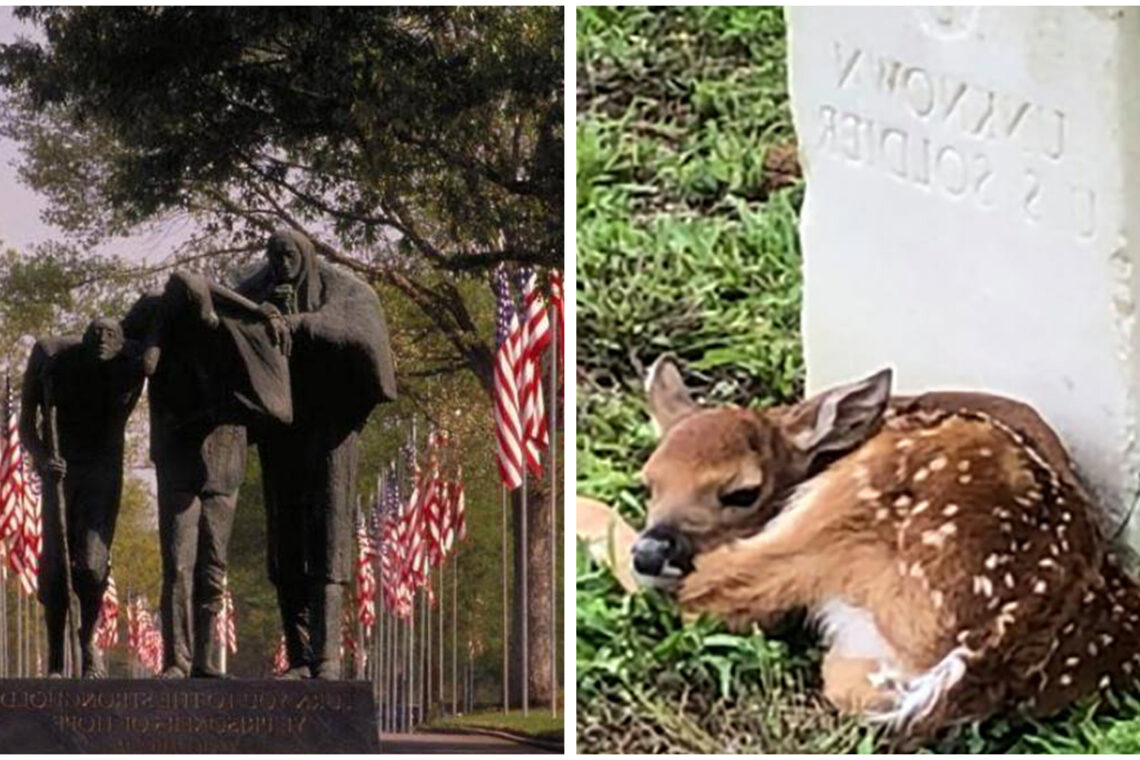
In a serene moment captured on camera, a young fawn was seen resting in a poignant location, drawing the attention and admiration of countless individuals. This tender scene unfolded within the tranquil surroundings of a national park located in Georgia, where the fawn nestled comfortably beside a gravestone dedicated to an unknown soldier, adorned with an American flag.
The captivating image was taken by James Taylor, a maintenance supervisor at the park, who shared the touching moment with the world. The photograph, which depicts the fawn peacefully curled up next to the gravestone marked “Unknown U.S. Soldier,” quickly gained traction, with thousands of people expressing their appreciation and reverence for the scene. Taylor’s observation not only highlighted the innocence of the fawn but also served as a reminder of the sacrifices made by those who have served the nation.
In his post, Taylor noted, “Today, I spotted this young guest cozying up and giving special honor to an unknown soldier resting in Andersonville National Cemetery.” This heartfelt observation resonated with many, inspiring a wave of comments from viewers who were moved by the symbolism of the fawn’s presence. One individual remarked, “What an honor! Our God is mighty in his creation,” reflecting the deep emotional connection people feel towards both nature and history.
Another commenter provided insight into the behavior of fawns, noting that these young deer are relatively vulnerable shortly after birth. A common practice among deer is for mothers to leave their fawns in a secure location while they forage for food. This instinctual behavior allows the fawn to remain hidden from potential predators. Responding to this observation, the Andersonville National Historic Site confirmed, “That’s exactly right! She came back later and got the fawn,” emphasizing the natural dynamics of wildlife parenting.
The significance of Andersonville National Historic Site extends beyond this touching encounter. The site was once the location of Camp Sumter, one of the largest military prisons during the Civil War, where many soldiers endured harrowing conditions. Established in 1865, the Andersonville National Cemetery remains an active burial ground, paying tribute to American service members. Additionally, the area includes a memorial dedicated to all American prisoners of war and hosts the National Prisoner of War Museum, which educates visitors about the experiences and sacrifices of those who served.
Wildlife experts frequently highlight the importance of allowing nature to take its course, especially when it comes to young animals. It is not uncommon for a mother to leave her offspring momentarily to secure food, and finding a solitary young animal does not necessarily indicate abandonment. The Massachusetts Division of Fisheries and Wildlife has stated that “adults are often nearby and visit their young only occasionally to avoid detection from predators.” This behavior is vital for the survival of the species, and intervention by humans is often unwarranted.
Every spring, the lives of many young animals are disturbed by people who take them from the wild in a misguided attempt to “save” them. In most cases, the best thing you can do for young wild animals is leave them alone.https://t.co/4dGf7iWkSE pic.twitter.com/99HSuy68SZ
— Massachusetts Dept. of Fish & Game (@MassDFG) May 20, 2020
In light of the fawn’s peaceful rest by the grave of an unknown soldier, one cannot help but reflect on the deeper meanings embedded within such moments. The image serves as a poignant reminder of the interconnectedness of life, the respect for those who have served, and the tranquility found within nature. As observers, we are invited to pause and consider the significance of both the fawn’s innocence and the sacrifice represented by the gravestone beside which it rests.
This encounter between wildlife and history is particularly meaningful in the context of a national park, where the preservation of both natural and historical elements is paramount. Parks like Andersonville not only safeguard the memories of the past but also provide a sanctuary for the wildlife that calls these spaces home.
In many ways, the fawn’s visit to the cemetery can be seen as a symbolic act, embodying a moment of peace and reflection. It highlights the importance of remembrance and honoring those who have fought for freedom. The natural world, in its purest form, often reminds us of our shared responsibilities toward one another and the environment.
As the story of the fawn circulates among people, it invites conversations about wildlife conservation, the significance of historical sites, and the respect owed to those who have served in the military. The fawn’s tranquil moment by the grave speaks to a broader narrative of reverence, connection, and the cycles of life.
In conclusion, the image of the fawn nestled beside the gravestone is more than just a charming photo; it encapsulates the essence of respect, remembrance, and the delicate balance of life within the natural world. Such encounters encourage us to appreciate the beauty surrounding us, recognize the sacrifices of those who came before, and foster a deeper connection to both nature and history. As we move forward, may we carry these lessons in our hearts, cherishing the moments that remind us of our place within the intricate tapestry of life.